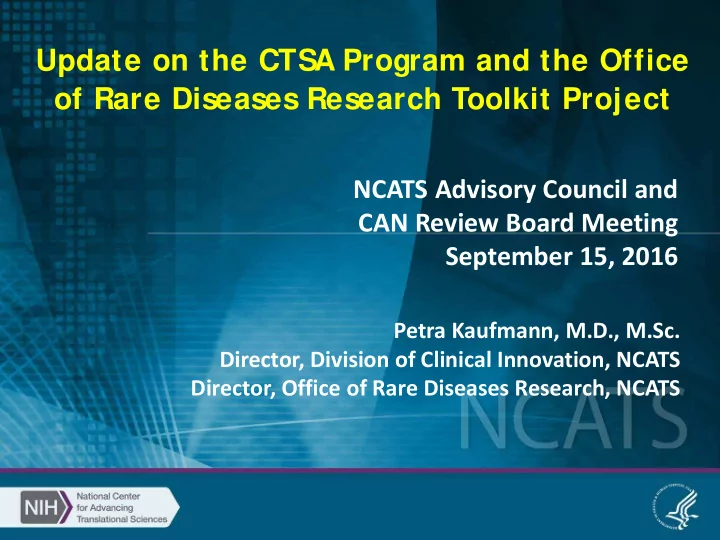

Update on the CTSA Program and the Office of Rare Diseases Research Toolkit Project NCATS Advisory Council and CAN Review Board Meeting September 15, 2016 Petra Kaufmann, M.D., M.Sc. Director, Division of Clinical Innovation, NCATS Director, Office of Rare Diseases Research, NCATS
CTSA Program Hubs Local Strength Leading excellence and innovation locally… Streamlining Community Understudied Informatics Training Processes Engagement Populations NCATS CTSA Program … and collaborations regionally and nationally Trial Innovation Collaborations Network Collaborative Biomedical Domain Task Future Recruitment Innovation Informatics Forces Innovation Center Innovations Awards Innovation (RIC) Trial Innovation Centers (TICs) CTSA Program Principal Investigators – Management Organization Steering Committee Partners: NIH Patient groups CTSA Program FDA Coordinating Center NCATS Industry NCATS/DCI PCORI, etc. Advisory Program Consultation Council Group 2 2
Collaborative Consortium for Translational Research 3444444 4444444 3 44
Collaborative Consortium for Translational Research Building on local and regional strength to bring more discoveries to health benefit: • Form virtual teams • Share information, practices, tools • Connect data systems • Implement efficient multisite studies • Integrate care and research • Have greater impact together 4
NCA TS SMART IRB Reliance Platform Streamlined, Multisite, Accelerated Resources for Trials Why? • Multisite studies are critical in getting from discovery to health benefit • To streamline the process, research centers are beginning to rely on each other’s IRB review What’s new: • NIH policy for single IRB announced on June 21, 2016 • NCATS Single IRB Workshop took place on May 2, 2016 • IRB master authorization agreement posted on NCATS website, ready for signing on • Current CTSA Program focus: workflow, training and IT processes • Pilot proceeding: CARRA - Childhood Arthritis & Rheumatology Research Alliance; Phase II of SMART IRB Project to launch fall 2016 SIREN PCORnet Other TICs Networks emergency trials NCATS SMART IRB Reliance Platform = Flexible platform 5 Thanks to: The IRBrely Team and CTSA Program Investigators ( IRBrely.org )
Streamlined Contracting Why? • Multisite studies require contractual agreements that are typically negotiated on a one-off basis • CTSA Program investigators have worked on streamlining the process to avoid redundancies and delays Accelerated Confidential Disclosure Agreement Accelerated Clinical (ACDA) Trial Agreement (ACTA) What’s new : Accelerated (Federal) Subcontracting (working with Federal Demonstration Project – FDP) https://www.ara4us.org/ 6
Harmonizing Investigator Qualification for Clinical Research Teams Why? Streamlined qualification, decreased redundancy, reduced time to trial startup What’s new: Good Clinical Practice (GCP) recommendations for clinical study investigators and coordinators developed and adopted by CTSA Program consortium Competency-based, clinical research professionals’ training curriculum developed for study investigators and coordinators Social and behavioral research best practices e-learning course developed for researchers and staff involved in social and behavioral clinical trials Evaluation plan for e-learning course under development by CTSA Program Workforce/Education Domain Task Force and University of Michigan CTSA Three manuscripts accepted to Journal of Clinical and Translational Science http://www.ctsa-gcp.org/ 7
Trial Innovation Network Why? To optimize clinical trials enterprise to accelerate translation • Data- driven “learning clinical studies system” so trials can recruit more quickly, retain participants, finish on-time and on-budget, and produce impactful, high-quality data • Leverage the talent, expertise & resources of the CTSA Program to transform clinical trials What’s new: Key components were launched in July 2016 • Trial Innovation Centers (TICs) • Recruitment Innovation Center (RIC) • Kick-off / introductory meeting to CTSA Program scheduled for Oct. 26, 2016 1
Common Metrics (CM) Initiative Common Metrics (CM) Why? To measure the impact of the CTSA Program on bringing discoveries to health benefit Each new topic area will have two components: What’s new: Supporting data-driven, results-based strategic decisions Not an evaluation, but a management tool Measuring the impact of the CTSA Program • At the hub Supporting Excellence Innovation • For the whole consortium How: Collaboratively, fostering shared accountability Focus on usefulness for strategic management 9
Common Metrics (CM) Initiative Implemented Topic Areas Topic Areas in Development • Collaboration • Careers in clinical and translational • Community Engagement research • Hub Research Capacity • IRB duration • Education and Training • Pilot funding publications and • Accrual funding • Informatics 10
Rare Diseases Toolkit Why? • Patient involvement and community engagement are vital throughout the translational research process • A wealth of educational and informational tools have already been developed by and for rare disease community Academia Disease foundations Government agencies Industry • But existing resources are dispersed, difficult to discover — especially for newcomers 2
What will the Toolkit project do for the rare diseases community? • Collaboratively create a well-designed source for online educational and informational research resources and tools . • Provide a single online portal with resources that patient groups can readily access along with context. • Improve coordination rather than re-create existing resources. • Facilitate opportunities to bring groups together , identify gaps in online resources, and disseminate information to patient groups. • Promote continuity across the lifecycle of the drug development process . Pre-clinical Trial readiness Trials Post-marketing 12
How do we plan to develop the Toolkit? • Planning group driven by patient group representatives • Inclusive*, transparent, collaborative • Focus on tools that are useful for research, easily accessible and practical Develop & Disseminate Ascertain Survey Demonstrate starting spring 2017, needs of landscape of via larger meeting(s) Sept. 20, 2016 patient groups available tools & webinars workshop • Educate & inform rare • Identify gaps & disease community opportunities • Develop programs that • Organize tools assist with use-case based on exemplary based strategies use cases * Tools are suggested for inclusion by the patient community. for patient groups at While we cannot capture everything, the initiative will be evolving and we invite comment and feedback. different stages 13
Recommend
More recommend